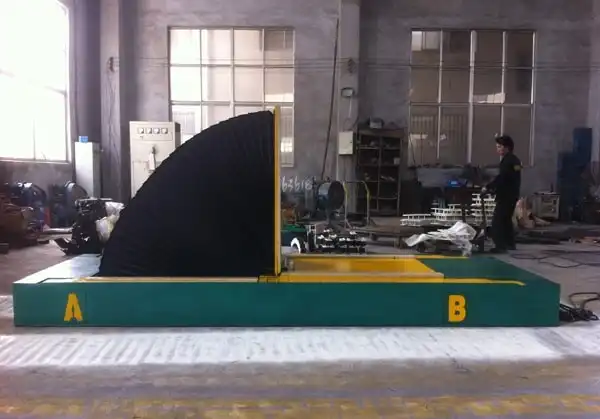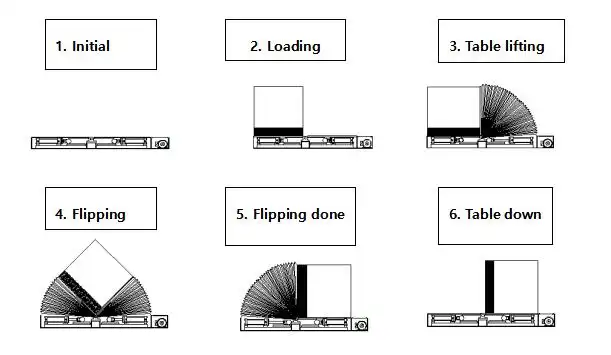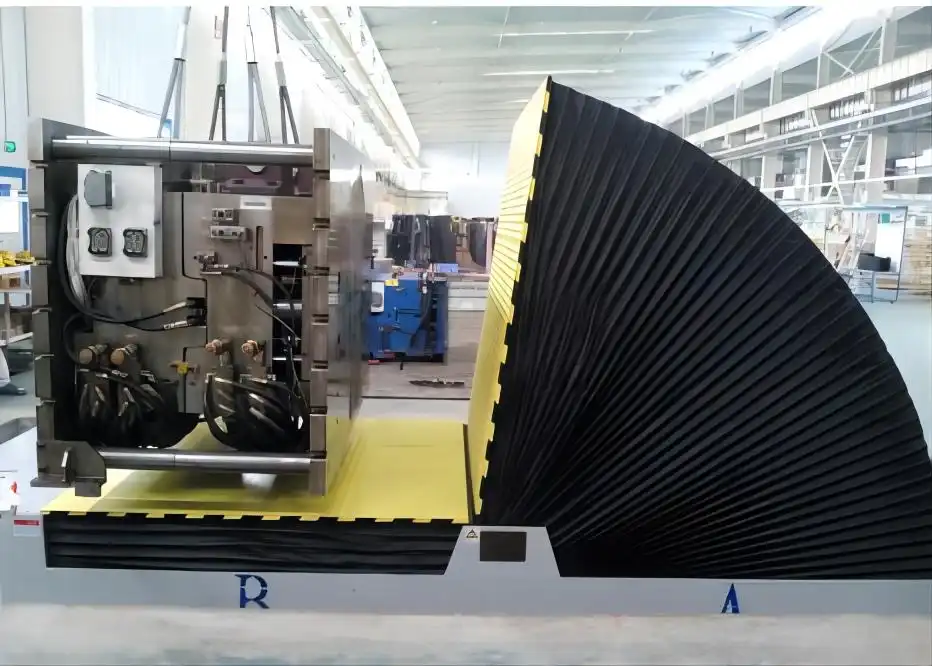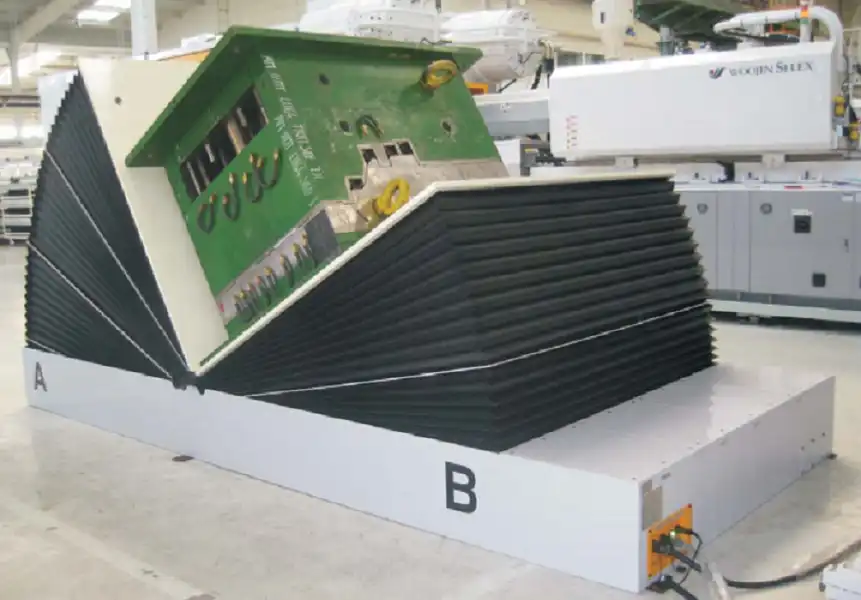Why Are American Factories Replacing Forklifts and Cranes with Mold Upenders?
I've spent my life on the factory floor. I started as an engineer, and I eventually built my own packing machine factory. I've seen firsthand how things work and, more importantly, how they can go wrong. A common sight in many plants is the overhead crane, lifting heavy loads, or a forklift, weaving through busy aisles. These are the traditional workhorses. But there's a problem. Every time a heavy, unbalanced load like a large mold or a steel coil is lifted and turned, there's a risk. A huge risk. It's a slow, tense process that can lead to damaged products, production delays, or even terrible accidents. Many factory owners I talk to accept this as a necessary evil. But what if it isn't? What if there was a way to handle these massive objects with precision, safety, and speed? A growing number of American factories have found a better way, and it's changing how they operate from the ground up.
American factories are replacing forklifts and cranes with mold and coil upenders primarily to increase operational safety, reduce expensive product damage, and improve overall workflow efficiency. This specialized equipment provides a controlled, stable method for turning heavy objects 90 degrees. It minimizes the serious risks associated with swinging crane loads or unstable forklift maneuvers. By creating a predictable and secure handling process, upenders directly address the core weaknesses of traditional methods, making them a strategic investment for modern manufacturing.

This shift is about more than just a new piece of equipment. It represents a fundamental change in thinking about factory logistics and safety. For leaders like you, who are constantly looking for an edge in efficiency and cost reduction, understanding this trend is crucial. It’s not just about avoiding problems; it’s about unlocking new levels of productivity. Let’s dive deeper into why this change is happening and what it could mean for your operations.
How Can Upenders Drastically Improve Workplace Safety?
Think about the most stressful moments on your factory floor. For many, it's watching a multi-ton steel coil or a priceless injection mold dangle from a crane. The operator has to carefully maneuver it, while workers below keep a safe distance. Or picture a forklift driver trying to nudge a heavy, round object into position. The center of gravity is high, and one small miscalculation can lead to a tip-over. These scenarios are all too common. The financial cost of an accident is huge, but the cost to your people and your company's reputation can be even greater. There is a solution designed specifically to eliminate these high-risk situations. Upenders are engineered from the ground up with safety as the number one priority, providing a secure and controlled alternative.
Upenders improve workplace safety by providing a stable, mechanically controlled process for rotating heavy loads. This design completely removes the inherent dangers of swinging loads from cranes and the instability of using forklifts for turning operations. By securing the load on a solid platform before and during the rotation, upenders significantly reduce the risk of dropping, slipping, and the catastrophic crushing injuries that can result from these failures.

Deconstructing the Risks of Traditional Handling
Early in my career, I saw a near-miss that I'll never forget. A large steel coil, weighing several tons, slipped from a C-hook attached to an overhead crane. It fell only a few inches back onto the stack, but the sound was deafening. If anyone had been in that spot, the outcome would have been tragic. That event showed me that even with trained operators and standard procedures, traditional methods carry a baseline level of risk that is hard to eliminate. Let's break down why.
Comparing Handling Methods
The core difference lies in how each method controls the load's center of gravity. Cranes and forklifts fight against gravity. Upenders work with it in a controlled environment.
| Risk Factor | Overhead Crane | Forklift | Upender / Tilter |
|---|---|---|---|
| Load Stability | Low (prone to swinging/spinning) | Medium (risk of tip-over) | High (secured on a platform) |
| Operator Proximity | High (operator nearby, risk to others) | High (operator on machine) | Low (operated from a safe distance) |
| Failure Mode | Catastrophic (dropped load) | Catastrophic (tip-over, dropped load) | Controlled (slow hydraulic failure, brakes) |
| Product Damage | High (dents from hooks/chains) | High (scuffs/dents from forks) | Very Low (flat, supportive surfaces) |
An upender essentially cradles the object. Whether it's a mold for the auto industry or a steel coil for construction, the machine's platforms support the load across a large surface area. The rotation is handled by powerful, reliable hydraulic or electro-mechanical systems. This means the movement is smooth and predictable every single time. There is no swing, no chance of slipping from a hook, and no risk of an unbalanced forklift tipping over. This allows you to redesign your workflow to keep people out of the danger zone entirely, which is the ultimate goal of any safety program. For a leader concerned with both uptime and employee welfare, this is not a small detail; it's a strategic advantage.
What Is the Real ROI of Investing in an Upender?
As a factory owner, I know every investment has to be justified. You look at the price of a new machine, like an upender, and your first thought is about the capital outlay. It can seem like a major expense, especially when you already have cranes and forklifts that are, in theory, doing the job. But this is where we have to look deeper. The real cost isn't on the price tag. It's hidden in the daily operations. It’s in the coil that gets dented by a forklift and has to be scrapped. It's in the production line that sits idle waiting for a crane to become available. It's in the high insurance premiums you pay because of the inherent risks of your current methods. An upender isn't just a cost. It is an investment that delivers a powerful and measurable return by solving these expensive hidden problems.
The real Return on Investment (ROI) of an upender is generated from multiple sources beyond simple labor savings. These include a dramatic reduction in product damage and scrap rates, significantly lower labor costs due to faster and more efficient cycle times, potential decreases in insurance premiums thanks to a safer work environment, and a measurable increase in production uptime by eliminating handling-related bottlenecks.

Calculating the Tangible and Intangible Returns
When a client asks me about ROI, I tell them to look beyond the initial purchase. The true value emerges when you analyze the total cost of your current process. For a steel mill owner like Javier, who manages a high-volume operation, even small percentages add up to massive figures. Let's break down where the value comes from.
Cost-Benefit Analysis: The Upender Advantage
This isn't just theoretical. I've worked with clients who saw these benefits firsthand. One company was losing about 1% of its steel coils to edge damage from forklift handling. After installing an integrated upender and conveyor system, their damage rate fell to virtually zero. For a high-capacity mill, that 1% can represent hundreds of thousands, if not millions, of dollars a year. That alone paid for the equipment in less than 18 months.
| Aspect | Traditional Method (Crane/Forklift) | Upender-Integrated Method |
|---|---|---|
| Capital Cost | Low (if equipment is existing) | High (initial purchase & installation) |
| Product Damage | High (dents, scratches, edge damage) | Negligible (controlled, supportive handling) |
| Labor Cost | High (requires skilled operator + spotters) | Low (often a one-button operation) |
| Cycle Time | Slow & Variable (5-10 minutes per turn) | Fast & Consistent (1-2 minutes per turn) |
| Uptime Impact | Creates bottlenecks, dependent on crane availability | Frees up cranes, creates smooth flow |
| Safety Costs | High (insurance, training, accident risk) | Low (engineered safety, lower premiums) |
The ROI calculation becomes a simple exercise. You sum the annual costs of scrap, wasted labor, and production downtime caused by your old methods. Then you compare that to the annualized cost of the new upender. For most high-volume American factories, the payback period is surprisingly short. This investment directly addresses key goals like reducing operating costs and increasing capacity utilization. It turns a cost center—material handling—into a competitive advantage.
How Do Upenders Integrate into a Modern, Automated Factory?
You are pushing for a "smart factory." You're investing in MES platforms, IoT sensors, and data analytics to make your entire operation visible and efficient. The last thing you want is to add a new piece of equipment that operates like an isolated island, unable to communicate with the rest of your systems. A "dumb" machine can create new bottlenecks and require manual intervention, which goes against the very idea of automation. You might worry that a heavy mechanical machine like an upender falls into this category. The good news is that modern upenders are designed for exactly this kind of environment. They are built to be smart, connected assets in your digital ecosystem.
Modern upenders integrate seamlessly into automated factories through advanced PLC controls and standard industrial communication protocols like PROFINET or EtherNet/IP. They are designed to receive commands from a central Manufacturing Execution System (MES), communicate with upstream and downstream equipment like conveyors or AGVs, and provide real-time status feedback. This connectivity allows them to become a fully integrated, intelligent component of a "lights-out" production line.

From Mechanical Workhorse to Smart Asset
The evolution of the upender is a perfect example of how industrial machinery has adapted to the digital age. The core mechanical function—turning something 90 degrees—is simple. But the technology surrounding it is sophisticated. This is a topic I am passionate about because it's where my world of engineering and my clients' goals of digitalization meet.
Key Integration Features of a Modern Upender
For a forward-thinking leader like Javier, who aims to deploy MES and IoT platforms, these features are not just "nice to have." They are essential. Imagine your production schedule is managed by the MES. The system knows a specific steel coil needs to be ready for the slitting line in 15 minutes. It can automatically send a command to the conveyor to move the coil to the upender, instruct the upender to rotate it from "eye to the sky" to "eye to the side," and then signal for it to be moved to the next station. No human intervention is needed. This is the foundation of achieving a 95% equipment uptime goal.
| Feature | Technical Component | Benefit for an Automated Factory |
|---|---|---|
| Centralized Control | PLC (Siemens, Allen-Bradley, etc.) | Easily programmed and integrated into the main factory control system. |
| Variable Speed | VFD (Variable Frequency Drive) on Motors | Allows for soft starts/stops, reducing mechanical wear and energy use. |
| System Communication | PROFINET / EtherNet/IP / Modbus TCP | Enables real-time data exchange with MES, SCADA, and other machines. |
| Predictive Maintenance | IoT Sensors (Vibration, Temperature, Current) | Monitors machine health, allowing you to fix problems before they cause downtime. |
| Integrated Safety | Light Curtains, Area Scanners, E-Stops | Creates a safe operating envelope that can halt the line if a person enters. |
The upender stops being just a tilter. It becomes a data point. It tells you its status, its cycle count, and when it needs maintenance. This data feeds directly into your analytics platform, helping you visualize production flow and identify opportunities for optimization. This is how you achieve a truly digital transformation—not by adding technology for its own sake, but by deploying smart, connected assets that solve real-world problems.
Why is an Upender a 'Total Solution' Beyond Just Tipping?
When you first look at an upender, you see a machine that performs a single, simple task: it turns an object 90 degrees. It's easy to think of it as a niche solution for a very specific problem. But if you only see the machine, you're missing the bigger picture. The real challenge in a factory is not just turning a coil or a mold. It's the entire process of moving that object from receiving, through production, to shipping—safely, quickly, and without damage. Focusing only on the single act of tipping fails to address the entire workflow. A modern upender, when implemented correctly, is much more than a tipper. It's the core of a total handling solution that can fundamentally change your logistics.
An upender provides a 'total solution' because it acts as a central hub that redefines the entire material handling workflow. It doesn't just tip a coil; it enables safer loading onto pallets, ensures correct orientation for automated machinery, and facilitates a seamless handoff to subsequent processes like strapping, wrapping, and labeling. It forces you to rethink the entire process, unlocking efficiency gains far beyond the single tipping action.

The Upender as the Heart of the Workflow
At SHJLPACK, our slogan is "TOTAL SOLUTION FOR WRAPPING MACHINE." This philosophy guides everything we do. I didn't get into this business just to sell machines. I got into it because I love solving complex process problems. I built my own factory from the ground up, and I learned that the biggest improvements come from looking at the entire system, not just the individual parts. An upender is the perfect example of this principle.
Process Step Comparison: Before and After
Let's look at a typical workflow for a steel coil in a factory that relies on traditional methods versus one that has integrated an upender as part of a total solution.
| Workflow Step | Traditional Method | Upender-Integrated Method |
|---|---|---|
| Receiving Coil | Coil arrives "eye to the sky" on a truck. | Coil arrives "eye to the sky" on a truck. |
| Unloading | Overhead crane with a C-hook lifts the coil. Slow, requires spotter. | Forklift with a special ram attachment quickly unloads coil onto a conveyor. |
| Orientation | Crane moves coil to a tipping area. Workers use straps/blocks to manually tip it, or a forklift attempts a risky turn. High risk of damage and injury. | Conveyor moves the coil into an automatic upender. The upender safely and quickly rotates it 90 degrees ("eye to the horizontal"). |
| Staging for Line | Crane or forklift moves the re-oriented coil to the start of the production line. Prone to delays and bottlenecks. | The upender places the coil directly onto another conveyor or an AGV that feeds the production line automatically. |
| Next Process | The process is now ready for slitting, stamping, or wrapping. | The process is now ready for slitting, stamping, or wrapping. |
As you can see, the upender isn't just one step. Its presence changes every other step in the process. It eliminates the most dangerous and time-consuming parts of the old workflow. It frees up your overhead crane for the heavy lifting tasks it was actually designed for. It reduces the reliance on forklifts in congested production areas. It creates a smooth, predictable, and often automated flow of material. This is what we mean by a "total solution." It's about helping clients like you grow your business by making your operations safer, faster, and more profitable. This is the knowledge I am dedicated to sharing.
Conclusion
Replacing old methods is not just about new machines. It's about choosing a safer, more efficient, and more profitable future. Upenders are a key step on that journey.





